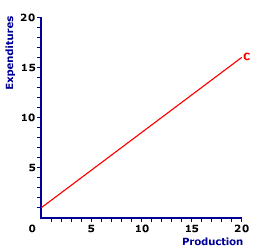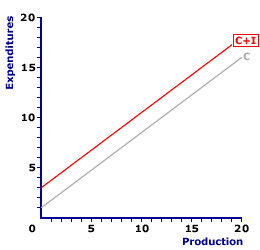
|
|
ALLOCATION: The process of distributing resources for the production of goods and services, and of distributing goods and services for consumption by households. This process of allocation is essential to an economy's effort to address the problem of scarcity. An allocation is efficient if the resources, goods, and services are distributed according to the economy's highest valued uses.
Visit the GLOSS*arama
|
|


|

|
                           TWO-SECTOR AGGREGATE EXPENDITURES LINE: A graphical depiction of the relation between aggregate expenditures by the two private sectors (household and business) and the level of aggregate income or production. The two-sector aggregate expenditures line combines consumption expenditures and investment expenditures. The slope of this aggregate expenditures line is based on the marginal propensity to consume, adjusted for the marginal propensity to invest if it is assumed to be induced when constructing the line. This is one of three aggregate expenditures lines based on the number of sectors included. The others are the three-sector aggregate expenditures line and the four-sector aggregate expenditures line. The aggregate expenditures line, which embodies the key Keynesian principle of effective demand, shows the relation between aggregate expenditures and the actual level of aggregate income or production in the domestic economy. The income and production measures commonly used are national income and gross domestic product. A two-sector aggregate expenditures line combines the expenditures of the two private sectors--household sector and business sector.The two-sector aggregate expenditures line forms the foundation of the standard two-sector Keynesian model. The two-sector Keynesian model combines the two-sector aggregate expenditures line with the 45-degree line to determine the equilibrium level of income and production. The two-sector Keynesian model provides an introductory analysis of Keynesian economics. Consumption expenditures contain the basic induce expenditure relation through the marginal propensity to consume that is so important to Keynesian economics. And autonomous investment expenditures provide the primary source of business-cycle instability. This two-sector aggregate expenditures line is commonly designated with a symbolic equation representing the two expenditures included in the line. where: AE is aggregate expenditures, C is consumption expenditures and I is investment expenditures.Two SectorsA good place to begin with the two-sector aggregate expenditures line is the two sectors that provide expenditures included in the line. These are the two private macroeconomic sectors--household sector and business sector. The government sector and foreign sector are not included.- Household Sector: This sector includes the entire, wants-and-needs-satisfying, eating, breathing, consuming population of the economy. In a word, it includes everyone, all consumers, all people, and every member of society. Pollyanna Pumpernickel, a hypothetical hardworking mother of two, is a representative member of the household sector. So too is Winston Smythe Kennsington III, a hypothetical affluent corporate executive.
- Business Sector: This sector contains the private, profit-seeking firms in the economy that combine scarce resources into the production of wants-and-needs satisfying goods and services. It includes proprietorships, partnerships, and corporations. OmniConglomerate, Inc., a hypothetical multi-billion dollar, multi-national, mega corporation, exemplifies a member of the business sector. However, Manny Mustard, a hypothetical proprietor who owns and operates a little sandwich shop is also part of the business sector.
Three ExpendituresThe aggregate expenditures line is the combination of expenditures by the three domestic macroeconomic sectors--household, business, and government. Each of these three sectors is responsible for a specific expenditure on gross domestic product--consumption, investment, and government purchases. And each expenditure is represented by a corresponding expenditure line.| Consumption Line |  | Investment Line |  |
The exhibit to the right presents the linear relations for each of the two aggregate expenditures.- Consumption Expenditures: The largest of the three expenditures on gross domestic product is consumption expenditures by the household sector. These expenditures are used to purchase everything from apple juice to cubic zirconium, essentially all of the goods and services that people purchase to satisfy wants and needs. The consumption line is the relation between these consumption expenditures and aggregate income or production. A representative consumption line, labeled C, is presented in the top panel of the exhibit to the right. This red line is positively sloped due to the Keynesian psychological law and the slope is measured by the marginal propensity to consume (MPC). The intercept is autonomous consumption.
- Investment Expenditures: The least stable of the three expenditures on gross domestic product is investment expenditures by the business sector. These are expenditures on capital goods, ranging from million-dollar factories to fifty-cent screw drivers. Investment expenditures are for fixed structures, equipment, and inventories (working capital). The relation between investment expenditures and aggregate income or production is illustrated by an investment line. Two alternative investment lines are presented in the second panel of the exhibit to the right. The horizontal gray line, labeled I, indicates autonomous investment, investment that is unaffected by income or production. The positively-sloped red line, labeled I', is induced investment, investment that is affected by income or production, and is measured by the marginal propensity to invest (MPI).
The Three-Sector LineTwo-Sector
Aggregate Expenditures Line |  |
A representative two-sector aggregate expenditures line is presented in the exhibit to the right. This red line, labeled C+I in the exhibit is positively sloped, indicating that greater levels of income and production generate greater aggregate expenditures by the two private sectors. This positive relation reflects the Keynesian economics principle of effective demand--more income means more expenditures.Also included in this exhibit is one gray lines, labeled C. This line represents the sequential stacking of expenditures by the two sectors, beginning with consumption (C), then adding investment for the two-sector aggregate expenditures line (C+I). This particular two-sector aggregate expenditures line assumes that investment expenditures are completely autonomous. This is why all both lines in the exhibit are parallel. The C+I line is parallel to the C line because investment is autonomous and constant at all levels of income and production. Because consumption is the only induced expenditure, which is measured by the marginal propensity to consume, the slopes of both parallel lines are also equal to the marginal propensity to consume. If investment expenditures are assumed to be induced, then the slope of the C+I line will become steeper. Two More LinesThe aggregate expenditures line actually comes in several varieties, depending on how many of the three expenditures are included and whether or not the expenditures are assumed to be induced or autonomous. The three most common aggregate expenditures lines represent the sequential inclusion of the three expenditures, beginning with consumption expenditures and investment expenditures, then adding government purchases and net exports.- Three Sectors: Another expenditures line is obtained by adding the "public" or government sector to the two-sector line. This three-sector aggregate expenditures line is the combination of consumption expenditures, investment expenditures, and government purchases. In addition, an adjustment of consumption expenditures for taxes is also commonly incorporated in this line. This expanded line is not only more realistic, it also enables the analysis of the impact of government fiscal policies on the economy, which is a key consideration of Keynesian economics. The three-sector aggregate expenditures may or may not include induced investment, induced government purchases, or induced taxes.
- Four Sectors: The complete expenditures line is constructed by adding net exports to the two-sector line. This four-sector aggregate expenditures line is the combination of consumption expenditures, investment expenditures, government purchases, and net exports. While the assorted expenditures can be assumed autonomous, as the "complete" aggregate expenditures line, anything that is realistically induced by income and production is generally assumed to be induced in the construction of this line.

Recommended Citation:TWO-SECTOR AGGREGATE EXPENDITURES LINE, AmosWEB Encyclonomic WEB*pedia, http://www.AmosWEB.com, AmosWEB LLC, 2000-2025. [Accessed: July 18, 2025].
Check Out These Related Terms... | | | | | | | | | |
Or For A Little Background... | | | | | | | | | | | | | | |
And For Further Study... | | | | | | | | | | | | | |
Search Again?
Back to the WEB*pedia
|



|

|
GRAY SKITTERY
[What's This?]
Today, you are likely to spend a great deal of time driving to a factory outlet wanting to buy either a coffee cup commemorating yesterday or a replacement remote control for your television. Be on the lookout for a thesaurus filled with typos.
Your Complete Scope
This isn't me! What am I?
|

|
|
The standard "debt" notation I.O.U. does not mean "I owe you," but actually stands for "I owe unto..."
|

|
|
"A winner is someone who recognizes his God-given talents, works his tail off to develop them into skills, and uses those skills to accomplish his goals. " -- Larry Bird, basketball player
|

|
ASEAN
Association of South East Asian Nations
|

|
|
Tell us what you think about AmosWEB. Like what you see? Have suggestions for improvements? Let us know. Click the User Feedback link.
User Feedback
|


|


